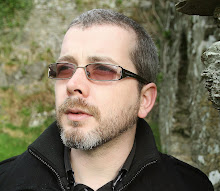
Liam McIllvanney’s All the Colours of the Town is a welcome addition to the quality post-Troubles literature that has gone from strength to strength in recent years. McIllvanney puts Northern Irish Loyalist criminals under the microscope in this tale of a Glasgow journalist out for the scoop of his career. The novel has been labelled a thriller, for marketing purposes, I suppose, but to me it’s more of a thought-provoking literary affair. And a brilliant one at that.
What stood out, first and foremost, was the quality of the prose. McIllvanney’s eye for detail and masterful use of imagery brings a fresh light to everyday sights in Northern Ireland. It wasn’t action, tension or bloodshed that gripped me. It was the writing. And really, in any book in which almost all of the violence and skulduggery happens off screen (or off the page), the writing has to be of a high calibre to appease this crime fiction junky.
The book’s protagonist, Gerry Conway, is a very well-constructed character. Three dimensional, chockfull of flaws and mostly well-intentioned. Conway is a Scottish political journalist for The Tribune who has fallen into a rut in his personal and professional life. He’s unhappy and unfulfilled, and so, after a little lethargic reluctance, he fastens hard to the opportunity for change when it presents itself as an aged photograph of a gathering of Northern Irish terrorists. His journey is fascinating and ultimately satisfying to this reader.
Although I fancy this book as closer to literary fiction than it’s marketing-friendly thriller tag, it’s not all style and flourish. There is a very well-conceived and structured plot at the core. And there are some classic mystery mechanisms at play. My balance wobbled more than once as McIllvanney revealed a goodly number of twists in the third act.
Belfast, seen through the eyes of Conway, is both similar to and starkly different from Glasgow. Both cities share a lot of the same political and social problems but it’s when an unexpected incongruity hits Conway that the observations really shine. I was very impressed by how well McIllvanney presented a very real image of Belfast. Especially since he now lives in New Zealand!
All the Colours of the Town makes for an interesting counterbalance to Stuart Neville’s successful first novel, The Twelve. McIllvanney’s book is not quite an inversion of Neville’s study of the Republican hierarchy in Northern Irish politics and crime, but it’s as close to it as anything else out there. If you’ve enjoyed one, I imagine you’ll enjoy the other, even if they are very different in writing style and approach to the subject matter. McIllvanney is a top shelf wordsmith. His writing is smoother than a thirty-year-old single malt and just as mature. It’s hard to believe that this is a debut novel, for all the very right reasons.
What stood out, first and foremost, was the quality of the prose. McIllvanney’s eye for detail and masterful use of imagery brings a fresh light to everyday sights in Northern Ireland. It wasn’t action, tension or bloodshed that gripped me. It was the writing. And really, in any book in which almost all of the violence and skulduggery happens off screen (or off the page), the writing has to be of a high calibre to appease this crime fiction junky.
The book’s protagonist, Gerry Conway, is a very well-constructed character. Three dimensional, chockfull of flaws and mostly well-intentioned. Conway is a Scottish political journalist for The Tribune who has fallen into a rut in his personal and professional life. He’s unhappy and unfulfilled, and so, after a little lethargic reluctance, he fastens hard to the opportunity for change when it presents itself as an aged photograph of a gathering of Northern Irish terrorists. His journey is fascinating and ultimately satisfying to this reader.
Although I fancy this book as closer to literary fiction than it’s marketing-friendly thriller tag, it’s not all style and flourish. There is a very well-conceived and structured plot at the core. And there are some classic mystery mechanisms at play. My balance wobbled more than once as McIllvanney revealed a goodly number of twists in the third act.
Belfast, seen through the eyes of Conway, is both similar to and starkly different from Glasgow. Both cities share a lot of the same political and social problems but it’s when an unexpected incongruity hits Conway that the observations really shine. I was very impressed by how well McIllvanney presented a very real image of Belfast. Especially since he now lives in New Zealand!
All the Colours of the Town makes for an interesting counterbalance to Stuart Neville’s successful first novel, The Twelve. McIllvanney’s book is not quite an inversion of Neville’s study of the Republican hierarchy in Northern Irish politics and crime, but it’s as close to it as anything else out there. If you’ve enjoyed one, I imagine you’ll enjoy the other, even if they are very different in writing style and approach to the subject matter. McIllvanney is a top shelf wordsmith. His writing is smoother than a thirty-year-old single malt and just as mature. It’s hard to believe that this is a debut novel, for all the very right reasons.




3 comments:
I was thinking of Stuart Neville's book as I read this, and I would definitely like to 'compare and contrast', as they say in American school essays--at least I think they do, though no one ever said it to me.
I don't know if this one has American publication yet, though.
Comparing this to Stuart Neville's THE TWELVE. Bloody hell, it must be good.
Seana - I'm not sure about American publication. I'll let you know when I find out.
Mike - Yes, it's that good.
gb
Post a Comment